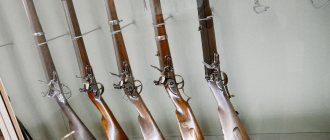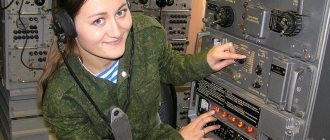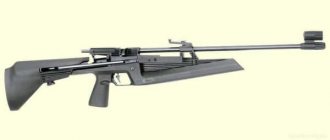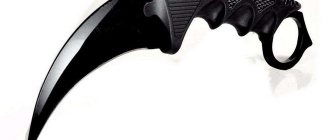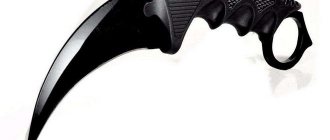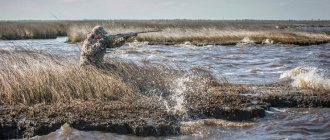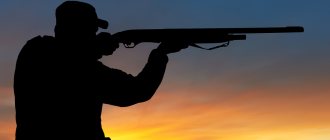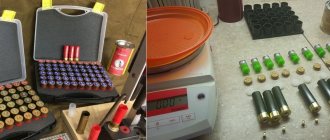- October 23, 2018
- Weapons and ammunition
- Human
Even the best guns and cartridges will not help protect yourself or catch game if a person does not know how to shoot a gun correctly. Of course, you can’t do this without practice. But for it to be successful and effective, a high-quality theoretical basis is necessary. An alternative is to use trial and error. But it is characterized by an increased amount of spending money and time.
Basic principles
Instructors know that there is no one way to properly hold a gun while shooting. This is influenced by several factors:
- physiological characteristics of the hunter;
- weapon weight;
- landscape of the area.
But there are basic principles. You need a fairly strong grip around the butt neck and fore-end. But your fingers should not become too tense and go numb. The following detail is especially important: the thumb of the hand that lies on the butt should fit tightly around its neck and under no circumstances slide onto the safety catch. Otherwise, when firing, the shooter may damage it with recoil. The finger is especially often injured by the upper bolt key.
How to position your hands
The hand that pulls the trigger should lie freely and should not be restrained by anything. Sometimes there are guns in which the butt is shaped in such a way that in order to properly grasp the gun you have to twist your wrist. This reduces the accuracy and efficiency of shooting. Professionals advise changing the shape of the front part of the butt comb or even completely replacing the rifle stock. This will give your hand more space. But it is not recommended to do this yourself. Such changes to the design should only be carried out by a master gunsmith.
The shooter usually places his second hand in the middle of the fore-end. In this case, it is especially important to control the grip force. Shooting masters teach that the forend should be held in the palm of your hand as if it were a handful of eggs. You may not get this grip right the first time, but you still have to master it.
Hunting big game allows you to use a little more force when holding the weapon. But the grip force on the fore-end should be kept to a minimum. Of course, it should be enough for confident and precise shooting control.
It is important to position your index finger correctly. Instructors advise placing it so that it is aimed at the target. At first, this hand position will not seem very comfortable, but over time the skill will take hold and become a habit. When the index finger is positioned in such a way that it seems to be pointing at the target, this helps the shooting accuracy at the level of instinct. Typically, the instructor will ask the novice shooter to raise his left hand with his index finger extended forward and mark his target. The brush should be held relaxed, without tension. Then the student is asked to turn his half-open palm upward. This will be the optimal position of the front hand when shooting.
Five Tips to Avoid Common Shooting Mistakes
Taran Butler, Grand Master shooter and Multi-Gun gold medalist
Whether you're a newbie amateur shooter or a professional shooter, there's always time to review the basics of pistol shooting. And, of course, shooting skills must be constantly practiced; without proper training, they can easily be lost.
Taran Butler, a Grand Master shooter and Multi-Gun gold medalist, has posted some tips on the basics of pistol shooting and how to avoid common mistakes.
Shooting stance
Correct shooting stance is important for an accurate shot. As in golf and other sports, stance is the foundation of the game, so make sure you have the right stance. Proper stance will allow your body to absorb the recoil and stabilize you for the next shot.
| Shooting stance | Don't Do That Butler said he often sees his students doing what he calls "fishing." Beginning shooters often do not pay attention to the position of their legs or body. They can stand upright, or lean back with their legs together. In this position, the recoil from the gun literally pushes you back, and since you are literally standing on your heels, you can lose your balance. The shoulders do not control the arms, and during recoil, the arms “fly” up. It ends up looking like they are "hooking" the swordfish while fishing. This may be useful for catching fish, but it is unlikely to be good for fast and accurate shots, not to mention that it is not safe. |
| Shooting stance | Do this: Get into a boxer's fighting stance. Turn to face the target, hunch your back slightly, and squeeze your shoulders together. Your feet should be slightly larger than shoulder width with your left foot (for a right-handed person) about 10-15 cm in front. Your knees should be slightly bent. Your weight should be evenly distributed on both feet. Your arms are slightly bent at the elbows, as if you are going to defend yourself in a fist fight. This stance will stabilize your body when shooting and you will have better recoil control. The arms will act as shock absorbers and the shoulders as support. |
Grab the weapon
Proper grip on a pistol means more than just lifting it up and holding it. This is actually the method of holding that allows you to get maximum shooting efficiency. You must hold the weapon in full control of the shooting, so that your hands do not shake from the effort.
| Grab the weapon | Don't Do This Many students hold the gun too low or do not support it correctly. A low hold will not allow for effective control of the pistol during recoil. Butler noted that he often sees students supporting the pistol like a "cup of tea"; This may be due to the influence of 80's action movies, but it is not an effective way to hold a pistol. In addition, he often sees the arrows crossing their thumbs. Again, these are not proper ways to grip a pistol. |
| Grab the weapon | Do this: Hold the pistol as high as possible in relation to the slide. The higher your grip, the easier it is to control recoil. Hold the pistol firmly with your shooting hand, as high on the back of the grip as the slide will allow. Point your thumb toward the front of the gun. Your middle finger should be positioned securely under the trigger guard. Use your “support” hand to wrap around the fingers of your shooting hand and use your palm to wrap as much as possible around the pistol on the left side. The index finger of your non-dominant hand should also be positioned under the trigger guard, and the thumb should point forward and be placed under the thumb of your shooting hand. |
Target:
get as many points of contact with the gun as possible. The more contact you have with the gun, the more effectively you can control recoil and the faster you can fire repeat shots.
Remember - when holding a gun, your supporting hand grips the gun with more force than your shooting hand.
Aiming and sighting picture
Aiming – alignment of the front sight in the rear sight; sighting picture - observation of the target through sighting devices. Aiming is critical to getting an accurate hit. The closer or larger the target, the less you need to aim.
The further or smaller your target, the more carefully you need to aim. Butler is a shooter who balances speed and accuracy, so his tips are aimed at achieving fast and efficient shooting.
Don't do this
Some novice shooters don't know what to focus on when aiming. Butler noted that some of his students become fixated on the target, while others rush to shoot before they even see the target.
Do this
Place the front sight in the rear sight slot and level it in height. Since the eyes cannot focus on the target and the front and rear sights at the same time, focus on the front sight. Although the target and rear sight will be slightly blurred, you can still line up all three elements while keeping the front sight in focus.
Aiming and sighting picture
This is the correct sighting picture. Depending on the type of sights, the aiming point will be either under the front sight or at its top. Practice quickly aligning the front sight with the rear sight and getting the correct sighting picture.
Processing the descent
Simple as it may seem, trigger control takes a lot of practice. Many inexperienced shooters aren't quite sure where their finger should be on the trigger, and they don't understand how they should actually pull the trigger.
| Processing the descent | Don't do it Butler often notices in his students a complete lack of control over trigger handling. Some of them use the crease between the first and second phalanx of the index finger. Additionally, he sees his students release the trigger completely after firing. Some people start to “slap” the trigger when shooting at high speed. All this is a strong hindrance to getting accurate hits. |
| Processing the descent | Do this Squeeze the trigger straight back, maintaining the sighting picture. Do not stop squeezing even after the shot. Your hand should be tense to maintain your grip, and at the same time relaxed enough for your finger to press the trigger smoothly. You need to squeeze the trigger with the first phalanx of your index finger. Ideally, the "pad" of the finger is best, but different pistols and the length of the fingers of the hand dictate which part of the first phalanx you use. To get a good follow-up shot, begin to slowly release the surviving trigger until you feel the trigger "reset." Depending on the pistol. Sometimes you can hear a clicking sound. Once you feel and/or hear the hook release, stop your finger and be ready to continue shooting. On subsequent shots, there is no need to fully release the trigger. |
How to properly distribute muscle effort
The secret here is simple. The hand that holds the fore-end must be pushed forward as far as possible, while the hand gripping the butt must be pulled back at the same time. With this grip, some tension is created, the shooter perceives less recoil and returns the barrel to the target faster. Shooting masters advise straining one of your hands less. When hunting, the leader is advised to leave the front hand. It becomes the main one when aiming at game.
Some hunters prefer to raise the gun with both hands in unison and point it at the target at the same time. This way they save time for shooting.
The position and work of the hands during shooting is largely an individual matter. But all experts agree on one thing: it is imperative to control the compression force of the gun. If the fore-end slips in your hand during a shot, then your grip should be strengthened. If your fingers turn white and numb from tension, then you need to loosen it.
Some hunters change the position of their hands from time to time. This helps them get the gun on target faster. The classic grip among shooters is the middle grip of the forend. But many keep their hand closer to the box. Placing it completely on the rear of the forend is risky. The hand is too tense, so it’s easy to miss the target. The gun is held by the front part of the fore-end only if it is too short.
Introductory information
In order to learn to shoot well, one uses either an experienced way or special training. But in the first case, you can devote your entire life to learning, but still not understand the many elementary subtleties of proper firing.
Therefore, in order not to waste time and money on understanding how to shoot a gun correctly, you need to prepare. In practice (for example, when hunting) you have to fire at fixed/moving targets. For example, if a hazel grouse is frozen on a branch ten meters away, then intuitively it is not difficult to hit it.
It is enough to throw the gun to your shoulder, bring the upper cut of the front sight to the point and smoothly, without jerking, pull the trigger. Although not everything is as easy as it might seem at first glance.
Specifics of shooting
Speaking about how to properly aim with a shotgun, it is necessary to note the fact that it is necessary to use both eyes in an open state. This is necessary in order to more accurately determine the distance to the target. This is very useful when it moves additionally and has a small affected area. For example, a duck that swims on a lake. In this case, it is advisable to aim for the neck. And you should not hesitate - after all, even if the target does not move quickly, it can leave the affected area. Many people spread rumors that it is necessary to keep the bar closed or open in specific cases. This is all fiction - everyone decides for themselves what is convenient for them. Also, do not forget about anticipation. Experienced hunters can take the correct distance without hesitation. Also, in cases where the game is still showing signs of life, it must be finished off immediately (but not with the butt of a gun, as it may break). After all, wounded animals often hide from hunters. In addition, it is necessary to accurately remember the places where game falls and try to quickly get it. It is also unacceptable to shoot at birds during migration when they fly over impassable thickets. After all, even if the game is killed on the spot, it will be difficult to find. And finding a wounded animal is a significant success. Therefore, it is always necessary to ensure that the game falls in a clean place.
Shooting at a moving target
It can be performed using various techniques - offhand or with a leash. In such cases, it is necessary to have a lightning-fast reaction and a spreading weapon. Every hunter needs to be able to accurately determine the distance to a target within a range of up to seventy meters. This is if a smoothbore gun is used. A rifled weapon requires correct determination of the distance at least within 300 meters. In addition, it is necessary to shoot, as experienced hunters say, always in moderation. And it is advisable to use smaller ammunition if this is reasonably possible. Thus, a duck will be more reliably hit by five small pellets than by one large one. Although you shouldn't tempt fate. For example, take shot No. 12 for bear hunting.
About the passion for large ammunition
This is quite common among hunters. And such a situation is unsatisfactory.
When discussing how to shoot a gun correctly, one cannot ignore the fascination with excessively large ammunition. After all, this leads to a decrease in shooting efficiency and an increase in the number of wounded animals.
For example, where fractions No. 2-3 are often used, you can get by with No. 7-8. Which, for example, is relevant for geese, black grouse, and ducks.
How to improve performance?
Beginners are advised to go hunting with experienced people. They will tell you how to properly hold a gun when shooting, aim, and shoot. If something was misunderstood, they will correct it. It is advisable to start with simpler guns that do not provide ample opportunity to fire large quantities of ammunition. For example, single- and double-barreled guns have a disciplinary effect, forcing you to approach hunting more carefully. After all, if there is only one cartridge, then if you miss, then there will be no more opportunity to get game. And if it is also dangerous (a bear or a wild boar), then the hunter himself may suffer - even death. Therefore, it is recommended to choose double-barreled shotguns. They give you another chance to improve the situation. Whereas if semi-automatic weapons are used, then when the hunter gets excited, he can release all the ammunition with little effect. But how much do they cost!
Education system
In the world there are Soviet and American. The first involves a gradual transition from simple to complex. The Soviet system emphasizes the study of the material part, theoretical training, and only after this comes practice. The Americans decided that it was better to teach something complex until a person could do everything necessary.
About Study Tips
First of all, you need to figure out how to properly aim a gun. It is advisable that it have a rear sight and a front sight. And then comes the turn of the stationary target. You can send it to a shooting range or to a wasteland for human settlements. Initially, it is necessary to teach how to hold the weapon so that the rear sight and front sight coincide. In this case, you need to stand in a stance, resting the gun on your shoulder. When the weapon is already confidently held in your hands, you can start shooting at a stationary target. But it’s worth aiming at the moving one for now. No need to worry. You should shoot calmly. The main goal is to learn how to fire well. Since almost everyone has shot an air rifle at some point, there shouldn't be any problems with this exercise. But at the same time it is always necessary to press the gun tightly to your shoulder. This simple tip allows you to reduce recoil and not throw the barrels away from the aiming point. This is very important for subsequent shots. It is necessary to strive to ensure that there is no gap between the cheek and the butt, that is, they must be pressed tightly against each other.
More tips
Your feet should be shoulder-width apart. If a person is right-handed, then you should move your left hand forward. The body must be tilted forward. This dampens the recoil to a certain extent. Then you can point the front sight at the target and shoot. There is no need to listen to would-be theorists who recommend pulling the trigger slowly. This must be done smoothly but quickly. If you waste time aiming for a long time and pressing the shutter, you can shoot into an empty place. After all, game is not a target. She won't wait. It is necessary to release the trigger with the first phalanx of the index finger. But beware of making a dash. It is necessary to shoot until all motionless targets at 20, 35 and 50 meters are quickly and confidently hit.
Hitting a moving target
Here it is important not to forget about the skills that were acquired in the previous stages. Shooting from a gun should be done frequently - preferably every other day or two. It is necessary to achieve a situation so that after raising the weapon, its butt is pressed tightly against the shoulder and cheek, and the bar is not visible.
When trying to hit a moving target, you must move your body, not your arms. They are needed solely to move vertically. Many people, when turning to the right, often involuntarily help themselves with their hands. To avoid this error, it is necessary to move so that the body is initially slightly offset relative to the aiming point.
This is the only way to learn how to properly shoot a gun at a moving target.
About anticipation
It is simply impossible to avoid this topic by talking about how to properly shoot ducks and other small game with a gun, which at the same time moves very quickly. You can take the bureaucratic route and learn the lead sizes that are taken when hunting from different angles and at different distances.
Or you can use other approaches. For example - calculations in buildings. Or use the barrel of a gun to calculate the required lead. The last option is also very easy. You also need to be prepared to lead the game if it notices danger and decides to change its trajectory.
Or he will simply decide to go somewhere else.
Correct Practice
When questions about how to properly shoot a hunting rifle are raised, elementary rules of behavior cause a lot of misunderstanding. For example, after the first shot, when the target is not hit, many people rush and shoot in the same direction a second time. This very often turns into a miss. Even if you have a semi-automatic machine. It must be remembered that each shot must be aimed. This is also true when there is an opportunity to hit the flocks. Many people believe that if you fire three, four or five shots at, for example, a bunch of ducks, they will literally fall out of the sky. All that remains is to collect them. And then they wonder why this doesn’t happen. But when one duck is taken at sight, then a second or third one may also turn up under the shot. There is also a mistake when taking aim at a flock at a great distance, and as a result the shells pass behind the last bird. Therefore, even if there is a large group of potential game, it is necessary not to forget about anticipation and other useful points, as well as the fact that shooting should always be exclusively targeted.
Selected moments
If you are interested in how to properly shoot clay pigeons with a gun, then it is advisable to go to the training field to hone your skills. Fortunately, the general points are similar to those discussed earlier. In addition, you can ask advice from skilled shooters who train there. It is also worth mentioning how to properly shoot from an underwater gun when hunting fish and other inhabitants of the deep sea. Here the principles discussed above fit very poorly. For example, the weapon must be aimed at the target even a second after the shot. This is necessary in order not to knock the projectile off target and reduce the number of misses. It is also advisable to constantly ensure the same injection level. For example, in the range of 24-27 kilograms. The hand and eye will get used to it over time and it will be easier to hit. We should also not forget that heavier harpoons provide strong recoil. Therefore, it may make sense to stick to light shells. And, of course, practice. You can't do without it.
How to position your elbows and hands
There is no consensus on this issue either. Some hunters believe that elbows need to be raised high enough when shooting. Others find that it is better to keep them in a natural position and spread their forearms slightly to the sides. Most choose the second method. High elbows also help with skeet shooting. They create a strong lock between the cheek and butt. During normal hunting, movements become constrained, and the shooter can miss even from an advantageous position from a short distance.
The hands of both hands should be positioned as comfortably as possible. This will allow you to easily control the weapon when selecting a target.
Tips for beginner hunters
A novice hunter must develop a skill in which both hands are equally involved in raising the gun to the shoulder. In this case, the barrel of the weapon must always be directed towards the target and not swing from side to side or up and down.
The left hand points the barrel at the target. The right one, at the last moment of aiming, moves the gun back and presses the butt to the shoulder. This movement should be performed with the back hand only. The butt of the gun is then inserted into the socket in the shoulder. This will dampen the recoil when firing. The elbow of the right hand is raised slightly up, but not raised.
Beginning shooters try to turn their right hand to the left during their first training sessions. This is mistake. On the contrary, you should turn it slightly to the right. This position will provide a softer grip on the gun and a smoother pull on the trigger.
Body position when shooting is also extremely important. If the body is tilted back, the hunter will not be able to cope with the recoil, and the barrel will suddenly jerk upward. You should ensure that the torso is slightly tilted forward, and the center of gravity is transferred to the front leg.
When hunting enthusiasts choose automatic weapons, they should remember that the balance when shooting in this case will constantly change as the cartridges are spent. The shooting line will also become higher.
Learning to hold a gun correctly
photo: Fotolia.com
I have a 1+4 grip, but they have a 2+3. I shared my findings with my friends and was laughed at. I came with this question to the editor of one weapons magazine and received an answer from him that these were, they say, “mannered boys.” This has already struck a chord with me.
I began to look, search, read, and as a result I received a certain body of information, which, having undergone editorial editing, may be of interest to other readers of the newspaper. Maybe someone will share their impressions and observations?
In popular literature, from article to article, the statement wanders that the barrels shoot, but the stock hits. The stock, as you know, consists of a fore-end, neck, butt and butt plate. The stock serves to direct the barrel(s) at the target and transfer the recoil that occurs at the moment of the shot to the shooter’s shoulder.
The stock should provide ease of handling of the gun, quick aiming and minimize the impact of recoil on the shooter's shoulder. This is all clear, and no one argues with this.
There are guns that fit and those that don’t, and one respected author claims that if you change the position of the hand holding the fore-end, you can pretty quickly get used to a gun that doesn’t suit you.
The famous Russian coach Oleg Kulakov once remarked: “To be frank, there is no shooting culture in Russia. And this is caused, oddly enough, by the weapons handling skills instilled in the army. Many hunters, even with great experience, make the same mistake when buying a gun.
Read the material “How to properly fit a gun for take-off shooting”
The buyer takes the gun, raises it, tries to aim and says: “mine!” or “not mine.” But he throws up this weapon like a Kalashnikov assault rifle! First of all, the buyer looks at whether this gun fits him or not. But where can it “lie” if he throws it incorrectly?!”
Alexander Posudin also agrees with his opinion, believing: “There are a lot of military men among the hunters. As a rule, almost all military personnel shoot from a hunting rifle the way they were once taught to shoot from a Kalashnikov assault rifle: the elbow is pressed to the ribs, and the shoulder is raised to the ear. And nothing can be done with them!”
| photo: Fotolia.com |
Despite the universally recognized value of a stock, many young hunters consider it nothing more than a handle for carrying a gun. They also believe that the neck and fore-end are needed so that there is something to hold on to (not to hold the gun, but to hold on!) when shooting.
As it turns out, this is a deep misconception! Both the neck and the forend help level out the shooter’s anthropometric characteristics and make aiming and shooting easier.
In order to verify the validity of this statement, you need to do a small experiment. Extend your hand forward and point your index finger at some distant object. Now pay attention to your wrist.
You will see that the arm is bent at the wrist. The hand and fingers, except for the index finger extended forward, will make an angle with the hand in the vertical plane equal to approximately 17 degrees and 12 degrees in the horizontal.
From an anatomical point of view, this is the so-called natural position of the hand. This position of the hand not only provides maximum freedom of movement in any direction, but is also the most comfortable position for the hand itself, so it is not surprising that the hand itself becomes in this position.
Read the material “Differences between a hunter and a shooter when hunting”
That is why the handles of the pistols are rotated in relation to the barrels by 107 degrees (90+17). If the handle of the pistol makes a right angle with the axis of the barrel, then it will not be very convenient to shoot from such a pistol, and it will be even more difficult to conduct instinctive aimless shooting from it. An angle of 12 degrees in the horizontal plane compensates for the bend of the arm at the elbow joint.
Once again, let me quote the above words: “If you change the position of the hand holding the fore-end, you can quite quickly accustom yourself to a gun that does not suit you.” They can be interpreted as follows: the shooting performance will ultimately depend on the position of the hands on the neck of the butt and fore-end.
The position of the hand determines the degree of its freedom. When shooting from a rifle, the forend must be firmly fixed. In order to reduce hand mobility, the shooter holds the rifle fore-end with his thumb on one side and four fingers on the other. This grip almost completely deprives the hand of mobility and rigidly fixes it.
| photo: Fotolia.com |
The pistol grip of the stock performs exactly the same function: the shooter bends his hand at the wrist, thereby rigidly fixing the hand, which ensures ease and correct aiming.
An indirect proof of this statement is the fact that double-barreled guns with horizontal barrels in England were equipped primarily with a pistol stock, and double-barreled shotguns with the same horizontal barrels were equipped with a straight stock, although, of course, exceptions only confirm the rules.
As for shooting from a smooth-bore weapon, the shooter must also hold the gun securely in his hands, but his hands should not limit his freedom of movement following the target. When shooting a shotgun, your wrists should be in a natural position.
Read the material “Choke tubes and flying shots”
Therefore, the grip of the fore-end of a smoothbore gun is done with the thumb and index fingers on one side and the three remaining fingers of the hand on the other. In this case, the index finger helps to point the gun towards the target. Do not aim, as in bullet shooting, but direct.
Thanks to this grip, the hand is in a natural position, which is most comfortable for the shooter. This grip helps reduce muscle tension. (Someone may ask: have you tried shooting like this yourself? I answer: I tried, I won’t say that it’s convenient, but rather unusual.)
It turns out that when shooting, both hands should be in a natural position? Nothing like this! This is simply impossible. When raising the gun, the shooter raises the hand holding the neck of the gun, and at this moment the angle formed by the hand and forearm changes.
| photo: Fotolia.com |
Features of human anatomy largely not only determine the shape of the forearm and neck, but also predetermine their relative position. Close your eyes, quickly extend both arms forward and clasp your index fingers together.
To successfully perform this exercise, a complex neuromuscular interaction is required. After all, in order to successfully connect the index fingers without seeing them, the brain must receive and process information about their relative position.
Features of human anatomy determine the position of the hands on the neck and forearm. They should be as close as possible to the longitudinal axis of the trunks. Any deviation from this position will inevitably lead to problems with the controllability of the gun and, as a consequence, to problems with aiming.
Let us again take, for example, English double-barreled shotguns with horizontal barrels. They usually have a straight stock. And semi-automatic machines with a powerful fore-end that hid the under-barrel magazine mostly have a stock with a pistol grip.
Read the material “Shooting while hunting: typical mistakes and annoying mistakes”
By the way, the pistol grip serves not only to hold the gun. It also helps the shooter control the position of the gun during recoil. And again, the British, who prefer lightweight charges, prefer guns with a straight stock, and the Americans, who prefer “magnums” and “supermagnums,” prefer guns with a pistol grip.
| photo: Fotolia.com |
The location of the gun's center of gravity depends on the distribution of mass among the nodes, and this point is unchanged, however, a change in the position of the shooter's hands on the stock can lead to a change in the shooter's perception of this very point.
You need to accustom yourself to take the gun every time so that the position of your hands on the neck and fore-end is the same, then there will be no problems controlling the gun while tracking the target.
Human anatomy and stock design are very closely related. When the designer takes into account the peculiarities of human anatomy when developing a stock, the gun turns out to be usable and vice versa.
Maxim Buluktaev July 29, 2022 at 02:31 pm
Choosing the right weapon
Often the design of the weapon itself interferes with accurate shooting. Experienced hunters know that sometimes there are guns that are designed so poorly that it is impossible to pick them up correctly at all.
It happens that the weapon was altered independently and was done incorrectly. Therefore, if, even if you follow all the rules of grip, it seems to you that the weapon in your hands is not obedient enough, then you should contact a professional gunsmith. Only a well-fitted gun in the hands of a good shooter will bring pleasure from shooting and produce results during the hunt.
